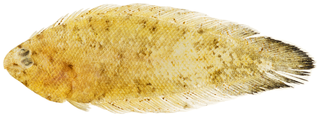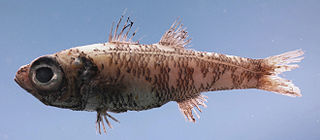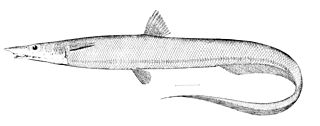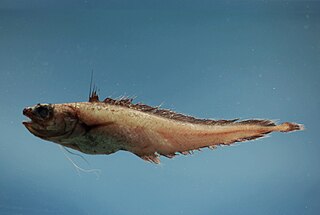
Citharichthys is a genus of flatfish in the large-tooth flounder family, Paralichthyidae. They have both eyes on the left sides of their heads. They are native to the oceans around the Americas, with a single species, C. stampflii off the West African coast. Most are found in relatively shallow depths, but the genus also includes species found in deep water and species that enter fresh water.

Pleuronectidae, also known as righteye flounders, are a family of flounders. They are called "righteye flounders" because most species lie on the sea bottom on their left sides, with both eyes on their right sides. The Paralichthyidae are the opposite, with their eyes on the left side. A small number of species in Pleuronectidae can also have their eyes on the left side, notably the members of the genus Platichthys.
Centroscyllium is a genus of big-eyed, deepwater dogfishes with no anal fin, a grey or black-brown body, and dorsal spines, with the second one being much larger than the first. Seven extant species are described.

Bothidae or lefteye flounders are a family of flounders. They are called "lefteye flounders" because most species lie on the sea bottom on their right sides, with both eyes on their left sides. The family is also distinguished by the presence of spines on the snout and near the eyes.

Coryphaenoides is a genus of rattails which is found in all oceans of the world. They are found in deep waters and C. yaquinae, recorded to 7,012 m (23,005 ft), is the only member in the family known from the hadal zone.

Pontinus is a genus of marine ray-finned fish belonging to the family Scorpaenidae, the scorpionfishes. The scorpionfishes in this genus are distributed in the tropical and warm temperate parts Atlantic, Indian and Pacific Oceans.

The Rhinochimaeridae, commonly known as long-nosed chimaeras, are a family of cartilaginous fish. They are similar in form and habits to other chimaeras, but have an exceptionally long conical or paddle-shaped snout. The snout has numerous sensory nerve endings, and is used to find food such as small fish. The first dorsal fin includes a mildly venomous spine, used in defense.

Symphurus is a genus of fish in the family Cynoglossidae found in the Atlantic, Indian and Pacific Ocean. Most species mainly occur in relatively shallow water, including estuaries. Some species are also found in deeper water, including S. thermophilus that lives at hydrothermal vents. These species are distinguished by merged dorsal, caudal and anal fins, the absence of a lateral line and pectoral fins, and the presence of only one pelvic fin. They are sinistral flatfishes, meaning that as adults, their crania are asymmetrical, with both eyes on the left side. The largest species grows to about 32 cm (1 ft) long.

Epigonus is a genus of fish in the family Epigonidae found in the Atlantic, Indian and Pacific Ocean. The genus was erected by Constantine Samuel Rafinesque in 1810.

Poecilopsetta is a genus of small righteye flounders mainly found in deep water in the Indo-Pacific. Two species, P. beanii and P. inermis, are from the West Atlantic.

Halosaurus is a genus of fish in the family Halosauridae. This genus currently contains the following recognized species:

Venefica is a genus of eels in the duckbill eel family Nettastomatidae. It currently contains the following species:

Alepocephalus is a genus of slickheads found in all oceans.

Laemonema is a genus of morid cods.
Dicrolene is a genus of cusk-eels.
Porogadus is a genus of cusk-eels.

Poromitra is a genus of ridgeheads. The 22 known species of Poromitra have been divided into five species groups according to variation in preopercle anatomy.

Ancylopsetta is a genus of large-tooth flounders mostly found along the Atlantic coast of the Americas with one species found along the Pacific coast.

Syacium is a genus of large-tooth flounders found in the Atlantic and Pacific Oceans. With the exception of S. guineensis from the Atlantic coast of Africa, all species are from the Americas. The largest species in the genus reaches 40 cm (16 in) in length.

Peristedion is a genus of marine ray-finned fish belonging to the family Peristediidae, the armoured gurnards or armored sea robins. These fishes are found in Atlantic and Indo-West Pacific ocean waters.


















